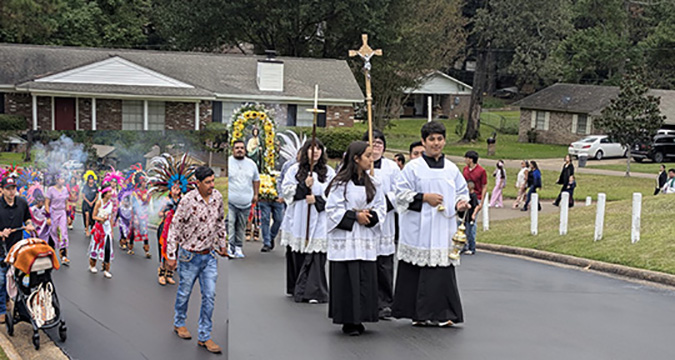
FEATURE PHOTO: … St. Jude celebration …


SPIRITUAL ENRICHMENT
CLARKSDALE – St. Elizabeth, Jubilee Year of Hope Celebration Mass, Wednesday, Nov. 19 at 5:30 p.m. Details: RSVP to church office (662) 624-4301.
DIOCESE/CLINTON – Diocesan Youth Adult Day of Reflection “Prepare the Way,” Saturday, Dec. 6, from 10 a.m. to 2 p.m. at Camp Garaway, Clinton. Register at https://bit.ly/YAReflection25. Deadline Nov. 19 at noon. Details: amelia.rizor@jacksondiocese.org.
GLUCKSTADT – St. Joseph, Millions of Monicas – Praying with confidence for our children, each Tuesday from 6:30-7:30 p.m. in the church. Join with other mothers and grandmothers as we pray for our children’s faithful return to the church. Details: email millionsofmonicas@stjosephgluckstadt.com.
PARISH & YOUTH EVENTS
STARKVILLE – St. Joseph, CYO Garage Sale, Saturday, Nov. 15 from 8-11 a.m. in the parish hall. Details: church office (662) 323-2257.
OLIVE BRANCH – Queen of Peace, Card Night hosted by the Men’s Club, Friday, Nov. 14 in the social hall. Dinner at 6 p.m. and games at 7 p.m. All are invited to this fun evening of cards and fellowship. Entry fee: $20 – includes poker chips, dinner and beverages. Games: three 50-minute rounds with 10 minute intermissions. Choose from Black Jack or Texas Hold’em. Details: sign up in the Commons or contact Tracy at (901) 828-4848.
EMPLOYMENT
JACKSON – Diocese of Jackson seeks an Assistant Stewardship and Development Director to support fundraising and stewardship, including the Annual Catholic Service Appeal; full-time. Requirements: bachelor’s (related field), 3+ years development/fundraising, strong writing skills, Excel, relationship skills; practicing Catholic in good standing. Apply by Nov. 15: send résumé and cover letter to Rebecca Harris, Diocese of Jackson, PO Box 2248, Jackson, MS 39225.
JACKSON – Diocese of Jackson seeks a Facilities Manager to support parishes and schools. Oversees contract review, construction, and diocesan property/life-health-safety policies; manages maintenance and repairs for the Chancery and diocesan sites. Bachelor’s/associate degree in facilities or construction preferred; CFM preferred; 5+ years facilities/construction management required. Email résumé and cover letter to Cathy Pendleton at cathy.pendleton@jacksondiocese.org.
CATHOLIC SCHOOL ADMINISTRATOR POSITIONS – The Diocese of Jackson seeks qualified, faith-filled leaders to serve as administrators in our Catholic schools. Positions available at St. Joseph School, Madison (Grades 7–12), St. Joseph School, Greenville (Grades PK3–12), and St. Elizabeth School, Clarksdale (Grades PK3–6). Applicants should be practicing Catholics with leadership experience, strong communication skills, and a commitment to Catholic education. For details and applications, visit jacksondiocese.org/administrator-employment.
JACKSON PARENTS SHARE YOUR VOICE IN THE METRO SCHOOL SURVEY
JACKSON – Families with children from early childhood through 12th grade are invited to take part in the Jackson Catholic Schools Family Survey on Education.
Whether your children attend Catholic schools or not, your feedback will help us better serve families across our Catholic community. The short survey asks about your experiences and how you make schooling decisions. Take the survey today at https://tinyurl.com/JacksonCatholicEd.
By Kimberley Heatherington , OSV News
(OSV News) — It’s among the shortest and perhaps least controversial of the Second Vatican Council’s 16 documents — four constitutions, nine decrees, and three declarations — and yet, it remains a touchstone for all the documents that followed concerning Catholic education.
“Gravissimum Educationis,” the Declaration on Christian Education, marks its 60th anniversary Oct. 28.
And while today’s classrooms are in many ways different than in 1965, the document’s basic principles remain as relevant as when it was promulgated by Pope St. Paul VI to guide Catholic schools in their work.
“At its heart, the document affirms two truths that still guide us today,” Steven F. Cheeseman — president and CEO of the National Catholic Educational Association, told OSV News.

“The first thing: That every child has the right to an education that develops the mind, the heart, and the soul,” he said. “And secondly, affirming parents are the primary educators of their children; that we play an important role as a ministry of the church to support them in that.”
Cheeseman noted the mission of Catholic schools has remained consistent throughout many eras.
“If you look at the history of Catholic schools in the United States, they’ve embodied that vision — forming generations of students in faith and knowledge, serving immigrant communities, the underserved, and consistently working to deliver academic quality while keeping Christ at the center,” he said.
There have, however, been changes in the Catholic educational landscape since “Gravissimum Educationis” was issued.
During the 1964-1965 school year, the nationwide network of Catholic parochial schools served about 5.6 million students. Since then, enrollment has dropped 70%, to around 1.7 million students today. Some 5,832 Catholic schools are staffed by 154,258 professional staff.
But ironically, the COVID-19 pandemic that swept across the globe in 2020 actually aided U.S. Catholic school enrollment.
Because Catholic schools were open when public schools were teaching remotely by video, “We saw a surge in enrollment in many places,” said Cheeseman.
“Those numbers have not dropped off precipitously once public schools opened. And I think that’s because once people were back in Catholic schools, they realized just what they offered,” he suggested. “They realized that it is nice to be in an environment that focuses on faith.”
While Cheeseman sees hopeful signs of growth — because schools are “getting back to that core mission; they’re not trying to chase the public school down the block” — regaining the numbers of students from the epoch of “Gravissimum Educationis” still seems a distant goal.
Cheeseman has a theory why.
“Many parishes and dioceses do not see a responsibility in ensuring access to Catholic education. Many have — and many bishops have really committed to that, and many pastors have,” he said. “But nationwide, one of the big differences between then and now — besides demographic shifts in recent times — is really the commitment of the church to Catholic education.”
“We are a ministry of the church; we’re fulfilling the church’s mission,” Cheeseman said. “And I think part of the sad reality is that we have lost, in many places, our connection to the parish; to the church.”
Father Friedrich Bechina, former undersecretary of the Vatican’s Congregation for Catholic Education and research associate at the Boston College Center for Higher Education Studies, agreed.
“I think there are some factors that changed,” said the priest, who serves as an international consultant to bishops’ conferences and dioceses. “On the one hand, the most important factor is demographics. Many parishes no longer have the minimum number of kids to be enrolled in a Catholic school.”
Father Bechina attributes that — at least in part — to a lack of foresight.
“I think that we would say it’s a bit of a homemade problem,” he offered, “because it was visible that the demographics would develop in this sense. And the parishes, they would have been able to predict how it would come — and that their school was no longer feasible. And also the decline of religious vocations.”
“So,” added Father Bechina, “those responsible for schools — and these were typically the bishops and the parish priests — could have seen that they would have to change the organizational and financial model of the Catholic schools, and that it could not be continued like it was.”
He also stressed the mission of evangelization.
“Catholic education is a way of evangelization, and is not an additional activity of the Church. The church can do many activities in addition to its key mission — but education is part of the key mission. Jesus himself was a teacher,” Father Bechina said. “The profession of Jesus, if you want, is teacher.”
He noted that in some ways, “Gravissimum Educationis” reaffirmed the central purpose of the Catholic school.
“There’s a strong emphasis which you find in ‘Gravissimum Educationis’ — this is something which is always true; but it is kind of rediscovered — that school has to do with relationship with the whole.”
“The Catholic school’s most important purpose is to bring students into personal relationship with Christ and with God,” he said. “I would say the baseline of it is that students would understand that they are seen; that they are understood; that they are loved; and that they are guided by God. This is, then, the Catholic school’s purpose — to translate this into the reality of human development and education.”
“Gravissimum Educationis” also foreshadowed schools that became more attentive to the student as learner versus the teacher as a transmitter of information.
“Something new is the focus on the right to education of the children — because by then, typically, it was the obligation of the parents that was underscored,” said Father Bechina. “And now this turns around, and it’s the right and obligation of the children — which is an interesting development, and I think anticipates what we today would call student-centered learning.”
John Garvey — former president of The Catholic University of America, and a current visiting professor of law at the University of Notre Dame — cited cultural shifts as another factor.
“Parochial schools were being encouraged to wall off religion; the culture was becoming more agnostic. Parents didn’t raise their children that way anymore,” he reflected. “So the enrollment plummeted, and why not?”
“What’s the point,” he continued, “of paying for an education that you could get in the public schools — there’s essentially no difference between them, except that you get a religion course. Why not send your kids to CCD classes?” said Garvey, referring to the Confraternity of Christian Doctrine, the parish-based religious education program for children who attend public or non-Catholic schools.
“So it was a really bad time for the church to say the world is God’s creation, and Christ should be the center of culture, and it’s the parent’s primary duty to educate their children — all true things,” Garvey said, “but the culture was going in exactly the opposite direction, and encouraging the churches to do the same.”
But like Cheeseman, Garvey said he also sees sparks of hope.
“I’m pleased at the effect that things like vouchers are having,” he said.
School vouchers provide public funds to parents to use for private school tuition or other educational expenses. The NCEA found that 31% of Catholic schools use parental choice programs, while 18% of students utilize them.
Garvey also noted two additional positive developments.
“One is that the law has been more accepting of the role of faith in the culture,” he said. “And the second is that young people — 25, 35-year-olds — who are raising children have themselves taken advantage of this, and taken the responsibility of educating their children in the faith.”
On the document’s 50th anniversary in 2015, Pope Francis created the Gravissimum Educationis Foundation.
“By this foundation,” the pontiff remarked to foundation members in a 2018 address, “the church renews her commitment to Catholic education in step with the historical transformations of our time.”
“It’s important for us all to realize that Catholic schools remain one of the church’s greatest gifts to society,” said Cheeseman.
“We have this opportunity to create a future, to form graduates who not only succeed academically and in their life, but also make a difference in the world. It’s a great responsibility; a great privilege — and,” he concluded, “‘Gravissimum Educationis’ recognizes that, and promotes that.”
(Kimberley Heatherington is an OSV News correspondent. She writes from Virginia.)
NOTES: A link to “Gravissimum Educationis” can be found here: https://www.vatican.va/archive/hist_councils/ii_vatican_council/documents/vat-ii_decl_19651028_gravissimum-educationis_en.html
By Cindy Wooden
VATICAN CITY (CNS) — Catholic education, which has changed over the centuries, must continue to evolve to help young people face the challenges not only of technology but of confusion about the meaning and purpose of life, Pope Leo XIV said.
“I call upon all educational institutions to inaugurate a new season that speaks to the hearts of the younger generations, reuniting knowledge and meaning, competence and responsibility, faith and life,” he wrote in an apostolic letter.
Titled “Disegnare Nuove Mappe Di Speranza” (“Drawing New Maps of Hope”), the letter was issued only in Italian Oct. 28. It marked the 60th anniversary of the Second Vatican Council’s Declaration on Catholic Education.
In the letter, Pope Leo formally declared St. John Henry Newman “patron of the church’s educational mission alongside St. Thomas Aquinas.”
The pope was scheduled to formally proclaim St. Newman a “doctor of the church” Nov. 1 in recognition of his contribution to “the renewal of theology and to the understanding of the development of Christian doctrine.” He was born in London Feb. 21, 1801, was ordained an Anglican priest, became Catholic in 1845, was made a cardinal in 1879 by Pope Leo XIII and died in 1890.

Even in the face of the digital revolution and the advent of artificial intelligence, Pope Leo said, Catholic schools and universities show “a surprising resilience.”
When they are “guided by the word of Christ, they do not retreat but press forward; they do not raise walls but build bridges. They respond creatively, opening new possibilities for the transmission of knowledge and meaning,” he wrote.
Pope Leo asked Catholic educators and educational institutions to focus on “three priorities”:
— “The first regards the interior life: Young people seek depth; they need spaces of silence, discernment and dialogue with their consciences and with God.
— “The second concerns a humane digital culture: We must educate in the wise use of technology and AI, placing the person before the algorithm, and harmonizing technical, emotional, social, spiritual and ecological forms of intelligence.
— “The third concerns peace — unarmed and disarming: Let us educate in nonviolent language, reconciliation and bridge-building rather than wall-building; may ‘Blessed are the peacemakers’ — (Mt 5:9) — become both the method and the content of learning.”
At the same time, the pope said, it is obvious that Catholic schools cannot ignore technology or avoid it, but they must be discerning about digital platforms, data protection and fair access for all students.
“In any case,” he said, “no algorithm can replace what makes education truly human: poetry, irony, love, art, imagination, the joy of discovery” and even learning from mistakes “as an opportunity for growth.”
In the letter, the pope briefly traced the history of Catholic education from the “desert fathers” teaching with parables, to the monastic study and preservation of classic texts and scholasticism’s highly structured and interdisciplinary curriculum.
But he also noted the huge array of Catholic saints throughout the ages who insisted that learning to read and write and add and subtract were matters of human dignity and so dedicated their lives and their religious orders to educating women and girls, the poor, migrants and refugees and others on the margins of society.
“Wherever access to education remains a privilege,” Pope Leo wrote, “the church must push open doors and invent new pathways because to ‘lose the poor’ is to lose the very meaning of the school.”
“To educate is an act of hope,” he said.
Catholic schools and universities, the pope wrote, must be “places where questions are not silenced and doubt is not banned but accompanied. The ‘heart speaks to heart,'” he said, quoting St. Newman’s motto as a cardinal.
Parents, as the Second Vatican Council affirmed, are the first and primary educators of their children, the pope said, but “Christian education is a choral work: no one educates alone.”
Those who teach in a Catholic institution, he said, “are called to a responsibility that goes beyond the employment contract: their witness is worth as much as their lesson.”
And while the human person is at the center of all educational initiatives, the goal is to help that person learn to see beyond him- or herself and “discover the meaning of life, inalienable dignity and responsibility toward others,” he wrote.
“Education is not merely the transmission of content but an apprenticeship in virtue,” Pope Leo said. “It forms citizens capable of serving and believers capable of bearing witness — men and women who are freer, not more isolated.”
The pope also called on Catholic schools and universities to be models of social and “environmental justice,” promoting simplicity and sustainable lifestyles and helping students recognize their responsibility for caring for the earth.
“Every small gesture — avoiding waste, making responsible choices, defending the common good — is an act of cultural and moral literacy,” he wrote.
By Kate Scanlon Gina Christian, OSV News
WASHINGTON (OSV News) – A coalition of Catholic organizations held prayer vigils across the country on Oct. 22 for what organizers called “a national day of public witness for our immigrant brothers and sisters.”
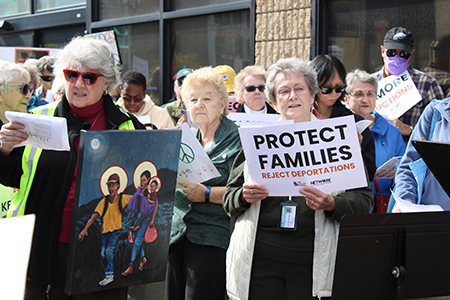
The vigils came amid growing concern from some faith communities — including a Catholic parish in Chicago — about the impact of the Trump administration’s rollback of a policy that prohibited immigration enforcement in sensitive locations, such as churches, schools, and hospitals.
The “One Church, One Family: Catholic Public Witness for Immigrants,” vigils took place in multiple locations around the country on Oct. 22. A second series of events is scheduled for Nov. 13, the feast day of St. Frances Xavier Cabrini, universal patroness of immigrants.
The grassroots initiative was spearheaded by the Jesuits West province, with additional sponsors including Jesuit Refugee Service USA, the Ignatian Solidarity Network, Maryknoll, Network Lobby for Catholic Social Justice, Pax Christi USA, the U.S. Conference of Catholic Bishops’ Migration and Refugee Services and several orders of women religious.
The protest and prayer vigil in the nation’s capital took place in front of the headquarters for the U.S. Immigration and Customs Enforcement as ICE employees entered the building and as rush-hour drivers occasionally honked at the group in apparent acknowledgment.
“We wanted to be a witness,” Judy Coode, communications director for Pax Christi USA told OSV News at the Washington vigil.
“Both as Catholics and also as U.S. citizens, we have a responsibility to bear witness to injustices that we see,” Coode said. “And so part of our tradition is to pray publicly. We have the right to do that, and so we take advantage of that, and we want to bear witness to those who are in power, who are making decisions. We want to call to their consciences, ask them to consider praying for another outcome, praying for another way to be.”
The day before the vigils, the Department of Homeland Security, which oversees ICE, objected on social media to a CBS News article about pastors expressing concern that fear of ICE raids is keeping some of their congregants away from church. In a post on X, DHS claimed it was “PROTECTING innocent people in our churches by preventing criminal illegal aliens and gang members from exploiting these places of worship.”
“DHS’s directive gives our law enforcement the ability to do their jobs. Our agents use discretion and have secondary supervisor approval before any action can be taken in locations such as a church or a school,” the post said.
In the CBS report, ICE Director Todd Lyons claimed that despite the rollback, houses of worship are not a target.
However, earlier in October, reports of ICE agents near St. Jerome Catholic Church in Chicago’s Rogers Park neighborhood prompted warnings of caution from its pastor, although a spokesperson for ICE denied the church was targeted, NBC Chicago reported.
The rollback of the sensitive locations policy is among the Trump administration’s immigration actions that have been met with criticism from the U.S. bishops. They recently offered their support to a lawsuit challenging the policy change, submitting an amicus brief, sometimes called a friend-of-the-court brief, to the U.S. Circuit Court of Appeals for the District of Columbia.
“The church is a sanctuary and refuge,” Art Laffin, a member of Dorothy Day Catholic Worker House, told OSV News at the Washington vigil.
Immigration enforcement actions in churches, he said, would be “a terrible sin and injustice, and so it really calls for all the people of God to stand together with those who are being targeted and criminalized, whether it’s in the sanctuary or whether it’s in the streets.”
Catholic social teaching on immigration also balances three interrelated principles — the right of persons to migrate in order to sustain their lives and those of their families, the right of a country to regulate its borders and control immigration, and a nation’s duty to regulate its borders with justice and mercy.
Sister of St. Joseph Bethany Welch, part of the national planning team for “One Church, One Family,” told OSV News in a phone interview Oct. 22, “It’s essential that we stand in solidarity, particularly with our brothers and sisters who are being detained.”
Sister Bethany had attended the Oct. 12 binational pilgrimage led by Bishop Gerald F. Kicanas, apostolic administrator of the Diocese of Tucson, Arizona, as part of a mission to stand in solidarity with migrants. She said her participation in the “One Church, One Family” Oct. 22 vigil at an immigration detention center in Newark, New Jersey, was a continuation of that effort — and of “the Gospel call to be attentive to those who are being harmed or marginalized.”
While immigrants are often seen “as other,” she said, “in fact, they are part of our church.”
Across the U.S., Christians account for approximately 80% of all of those at risk of Trump’s mass deportation effort, with the single largest group of affected Christians being Catholics, according to a joint Catholic-Evangelical report published by World Relief. The report found one in six Catholics (18%) are either vulnerable to deportation or live with someone who is.
“The church in Philadelphia, the church in Newark, the church in D.C. has been built and sustained through various histories of migration, whether that be Irish immigrants or Latin American immigrants or African or Haitian, etc.,” said Sister Bethany. “So often, as we become more prosperous or have more advantage, we forget our origins and our own humble beginnings.”
She added that “lack of memory,” along with a “scarcity mindset” — which fails to see that God’s love, compassion and mercy are “enough for all of us” — lie at the core of anti-immigrant sentiment.
According to Pew Research Center data released in June, more than four out of 10 Catholics in the U.S. are immigrants (29%) or the children of immigrants (14%). Eight out of 10 Hispanic Catholics are either born outside the U.S. (58%) or are the children of an immigrant (22%), while 92% of Asian Catholics are either immigrants (78%) or are the children of an immigrant (14%). In contrast, the vast majority of white Catholics are three generations or more removed from the immigrant experience: just 6% were born outside the U.S., with another 9% born in the U.S. to at least one immigrant parent.
Sister Bethany said the “One Church, One Family” vigils are “an invitation to remind ourselves where we came from,” she said.
Several dozen participants at a “One Church, One Family” vigil in Philadelphia, which took place outside of that city’s ICE offices, reflected on Christ’s announcement of his earthly mission to the poor, the blind and the captive, as recounted in Luke 4:16-30.
“Who are the poor among us who need to hear the Gospel, and who are the blind who need to recover their sight?” asked Sister of St. Joseph Linda Lukiewski, one of the event’s speakers.
Sister Linda — whose longtime ministry has included assignments in Central America and among U.S.-based Latino communities — responded, “I believe that the poor among us who most need to hear the Gospel are those who lack a sense of compassion and a sense of justice, who suffer from poverty of right judgment, and who are deficient in the knowledge that we are all brothers and sisters, and that we all deserve respect and dignity. I believe the poor among us are those starving for power and domination.”
Peter Pedemonti, founding member and co-director of New Sanctuary Movement of Philadelphia — an immigrant advocacy nonprofit based on Catholic teaching — noted in his address that “we are standing in front of some captives right now.” He said “at least four people” had been arrested by ICE that morning and were in detention in the building behind vigil participants.
“Let us hold those people who are in holding cells behind us in our hearts, in our prayers,” said Pedemonti.
He also urged those present to “let our hearts break over and over again” so that such detentions do not become “normal.”
(Kate Scanlon is a national reporter for OSV News based in Washington. Follow her on X @kgscanlon. Gina Christian is a multimedia reporter for OSV News. Follow her on X @GinaJesseReina. OSV News national news editor Peter Jesserer Smith contributed to this report.)
NOTES: More information on the One Church, One Family vigils can be found here: https://1family.us/
By Cindy Wooden , Catholic News Service
VATICAN CITY (CNS) – The pursuit of synodality should strengthen the Catholic Church’s mission of proclaiming the Gospel and help all Catholics learn to collaborate to make the world a better place, Pope Leo XIV said.
“As Pope Francis reminded us on numerous occasions,” the pope said, the purpose of synodality “is to help the church fulfill its primary role in the world, which is to be missionary, to announce the Gospel, to give witness to the person of Jesus Christ in every part of the world, to the ends of the earth.”
That witness includes speaking up for justice, caring for the planet and promoting peace, Pope Leo said during a meeting late Oct. 24 with participants in the Jubilee of Synodal Teams and Participatory Bodies.
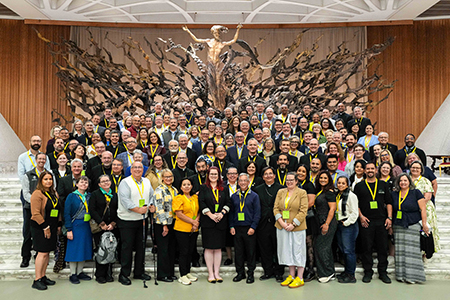
“The church has a voice, and we need to be courageous in raising our voice to change the world, to make it a better place,” he told the pilgrims, who included about 150 representatives from the United States with 15 U.S. bishops.
During the evening meeting, the pope listened to seven regionals reports on the implementation of the 2021-2024 Synod of Bishops on synodality and answered a question from each regional representative. Pope Leo took notes during the presentations, and his responses appeared to be unscripted.
Two questions drew strong applause from participants, a reaction Pope Leo noted in his responses. The first applauded question was about changing the minds of “bishops and priests who are concerned that synodality may diminish their authority as pastors”; and the second was whether the pope believed “equality between men and women in the church can become a lived reality in the future.”
Canadian Bishop Alain Faubert of Valleyfield, Quebec, gave the North American report, which ended with the question about getting all bishops and priests onboard.
Pope Leo said there is a need “to invite the priests, particularly, even more so than the bishops, I think, to somehow open their hearts and take part in these processes. Oftentimes, the resistances come out of fear and the lack of knowledge.”
The synodal process of listening to one another without immediately judging or defending one’s position has practical applications, he said.
Apparently referring to the breakdown of U.S.-Canada talks about trade and tariffs, the pope noted that the two countries “are experiencing even great difficulties. Two countries that were once considered the closest allies, at times, become separated from one another, and it’s another proof, another expression, of why synodality — listening and dialogue — are so important, and how they have concrete applications in our daily lives.”
People committed to synodality in the church need to be patient, though, he said. “We have to understand that we do not all run at the same speed, and sometimes we have to be patient with one another, rather than a few people running ahead and leaving a lot behind, which could cause even a break in an ecclesial experience.”
Presenting the European report, Klara-Antonia Csiszar, a professor of theology in Linz, Austria, told Pope Leo that “the question of women remains an important issue throughout Europe. In many local churches in the West, impatience for greater female participation is an open reality, while elsewhere, debates on the diaconate or on women’s leadership encounter resistance, skepticism or fear.”
Responding, the pope began by telling the delegates that sometime in the 1970s he remembers asking his mother if she wanted to be equal to men. “And she said, ‘No, because we are already better.’ And she was not joking.”
“Leaving aside the most difficult themes that are being studied by study groups,” particularly the question of ordaining women to the diaconate, Pope Leo said he believed the lack of equality for women in the church is due mainly to “cultural obstacles.”
“I mean women could play a key role in the church, but there are priests and bishops who hesitate,” he said. “There are cultures in the church where women still suffer because of inequality. In some cultures, women are considered as second-class citizens and in reality, do not enjoy the same rights as men.”
A challenge for the church, Pope Leo said, is to “understand how we can promote respect for the rights of everyone, men and women. How can we promote a culture in which these things become not only possible, but they become a reality, a culture in which there is co-participation of all the members of society, each according to their vocation, so everyone can play a role, can have a role of responsibility in the church.”
The church, he said, must find ways to “to transform cultures according to the values of the Gospel. Unfortunately, often the way which we live out our faith is influenced more by our culture than by Gospel values.”
Por Joanna Puddister King
MAGNOLIA – La pequeña pero animada comunidad católica de la parroquia St. James the Greater en Magnolia se reunió el sábado 5 de octubre para celebrar 153 años de fe, amistad y perseverancia, un legado que comenzó como una misión rural y continúa hoy en día como una próspera parroquia en el sur del condado de Pike.
Aunque se anunciaba como la celebración del 150 aniversario de la parroquia, el evento se había pospuesto varios años debido a la pandemia. Cuando los feligreses finalmente se reunieron, la alegría y la gratitud eran evidentes.
El obispo Joseph R. Kopacz presidió una misa al aire libre bajo carpas blancas instaladas junto a la histórica iglesia de madera, que no podía albergar a la gran multitud que acudió a la celebración. Concelebraron con el obispo Kopacz el padre Suresh Thirumalareddy, párroco; el padre Bill Henry, antiguo párroco; y el padre P. J. Curley, que en su día prestó servicio en la región.
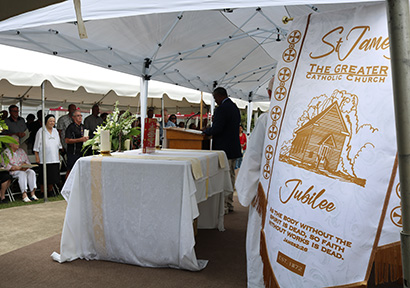
El alcalde de Magnolia, Marvin Brumfield, se unió a la celebración y presentó una proclamación en la que reconocía a St. James por su presencia histórica y sus contribuciones a la comunidad. Los feligreses y los invitados de todo el condado de Pike se reunieron para disfrutar de la música, la camaradería y una abundante comida sureña después de la misa. La tarde incluyó una subasta silenciosa, pintura facial para niños y comida preparada por feligreses y amigos de parroquias cercanas.
“Es pequeña, pero poderosa”, dijo la feligresa Vicki Todd, que se mudó a Magnolia de forma permanente hace nueve años por St. James. “Hemos pasado meses preparándonos para este día. La gente cree en la parroquia de St. James: nuestra pequeña iglesia es tan hermosa como puede serlo”.
La ministra de música Celena Johnson, que dirige la música desde 2019, coordinó un coro mixto formado por feligreses y músicos de las parroquias de St. James y St. Alphonsus en McComb, lo que refleja los profundos lazos que unen a ambas comunidades religiosas. “Me siento muy afortunada de tenerlos”, afirmó. “Lo mantenemos en familia”.
Desde sus inicios en la década de 1860, St. James ha dependido de ese sentido de familia. La parroquia tiene sus raíces en el padre Henry Picherit, quien celebraba misa en hogares locales antes de que se terminara de construir la primera iglesia en 1874 y se dedicara a Santiago el Mayor. Sacerdotes de Osyka, McComb y Chatawa sirvieron a la misión a lo largo de décadas, incluidos los redentoristas y las Hermanas Escolares de Notre Dame, cuya presencia en la cercana Chatawa forjó profundos lazos espirituales que perduran hasta hoy.
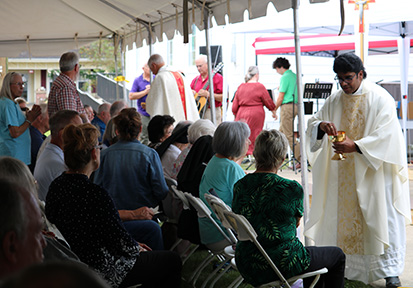
Varias hermanas que alguna vez vivieron o prestaron servicio en Chatawa regresaron para el aniversario, entre ellas la hermana Gemma Marie Dittle, SSND, quien elogió el liderazgo del padre Suresh. “Es muy dedicado y le encanta enseñar y servir. Fue una celebración preciosa”, afirmó. La hermana Marie Clare Powell, de 99 años, asistió en honor a una amiga de toda la vida, la hermana Mary Clared, que tocó el órgano durante casi 30 años. “Éramos compañeras de clase; ella era una de las miembros más fieles de St. James”, recordó.
St. James siguió siendo una misión de St. Alphonsus McComb hasta el 1 de noviembre de 2019, cuando el obispo Kopacz la elevó a la categoría de parroquia, reconociendo su constante crecimiento y su servicio a los católicos de todo el sur del condado de Pike.
El obispo Kopacz dijo: “Desde los primeros días en que los redentoristas establecieron esta pequeña iglesia misionera, se han convertido en una hermosa expresión de seguidores devotos y llenos de fe de Cristo, que comparten su Buena Nueva entre ustedes y con sus vecinos del condado de Pike”.
Para los feligreses, este hito fue más que una mirada al pasado: fue una renovación de su compromiso mutuo. “Que Dios siga bendiciéndolos por su dedicación y celo por su Iglesia”, dijo el obispo Kopacz.
CIUDAD DEL VATICANO (CNS) — La búsqueda de la sinodalidad debería fortalecer la misión de la Iglesia Católica de proclamar el Evangelio y ayudar a todos los católicos a aprender a colaborar para hacer del mundo un lugar mejor, dijo el Papa León XIV.
“Como nos ha recordado el Papa Francisco en numerosas ocasiones”, dijo el Papa León, el propósito de la sinodalidad “es ayudar a la Iglesia a cumplir su papel principal en el mundo, que es ser misionera, anunciar el Evangelio, dar testimonio de la persona de Jesucristo en todas partes del mundo, hasta los confines de la tierra”.
Ese testimonio incluye defender la justicia, cuidar el planeta y promover la paz, dijo el Santo Padre durante una reunión celebrada el 24 de octubre con los participantes en el Jubileo de los Equipos Sinodales y los Órganos Participativos.
“La Iglesia tiene voz, y debemos ser valientes a la hora de alzarla para cambiar el mundo, para hacerlo mejor”, dijo a los peregrinos, entre los que se encontraban unos 150 representantes de Estados Unidos, incluidos 15 obispos estadounidenses.

Por Joanna Puddister King
SALTILLO, México – El obispo Joseph Kopacz y el obispo Louis Kihneman, de Biloxi, viajaron juntos a Saltillo, México, del 15 al 20 de octubre, continuando una larga tradición de amistad y fe compartida entre Misisipi y la Diócesis de Saltillo.
El viaje supuso la undécima visita del obispo Kopacz a la misión fundada por el padre Patrick Quinn hace más de 50 años. El padre Quinn, que prestó servicio en Misisipi antes de ser destinado a México en 1969, trabajó incansablemente para tender puentes de fe entre el pueblo de Saltillo y los fieles de Misisipi. Hoy en día, su legado sigue vivo a través de la Misión de San Miguel y las numerosas capillas que se extienden por el paisaje desértico.
Durante su peregrinación de cinco días, los obispos celebraron la Eucaristía en parroquias urbanas y comunidades rurales, visitaron la tumba del padre Quinn en la Parroquia del Perpetuo Socorro y se unieron a las familias locales en alegres procesiones en honor al Santo Niño de la Buena Salud. En San Miguel, se reunieron con los feligreses para celebrar la misa antes de recorrer las calles en procesión, rodeados de colorido, canciones y alegría llena de fe.
La visita también incluyó misas de confirmación en Garambullo y Tanque del Cerro, comidas y convivencia con los sacerdotes locales, y tiempo dedicado a pequeños ranchos del desierto donde la gente recibió a los obispos con los brazos abiertos. El cuarto día, llovió sobre el desierto por primera vez en los once años de visitas del obispo Kopacz, un momento que llenó a las comunidades de agradecimiento y alabanza.
Durante su estancia en Saltillo, los obispos también visitaron al padre Adolfo Suárez, un sacerdote diocesano de la parroquia de San Miguel en Forest y sus misiones, que lleva desde abril prestando servicio en la Misión de San Miguel. El padre Adolfo regresó a México a principios de este año debido a las restricciones migratorias de Estados Unidos que afectan a muchos sacerdotes y religiosos extranjeros que prestan servicio en diócesis de todo el país.
El obispo Kopacz sigue creando conciencia sobre la Ley de Protección de los Trabajadores Religiosos (RWPA), una legislación bipartidista que permitiría a sacerdotes, hermanas y otros ministros como el padre Adolfo permanecer en Estados Unidos mientras esperan la residencia permanente. «Estos hombres y mujeres fieles sirven a nuestras parroquias y a nuestro pueblo con dedicación y amor», dijo el obispo Kopacz. «Su ministerio es esencial para la vida de nuestra Iglesia».
«Cada visita a Saltillo es un recordatorio de la universalidad de nuestra Iglesia», añadió el obispo Kopacz. «Puede que vivamos lejos unos de otros, pero compartimos la misma fe, la misma esperanza y la misma alegría en Cristo».
La Misión de Saltillo sigue siendo una colaboración viva entre las diócesis de Jackson y Saltillo, un vínculo fortalecido a través de la oración, la presencia y una misión compartida de servir al pueblo de Dios.
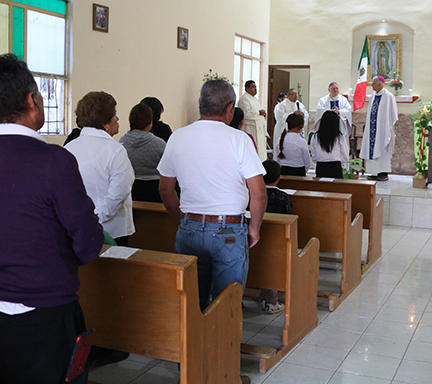
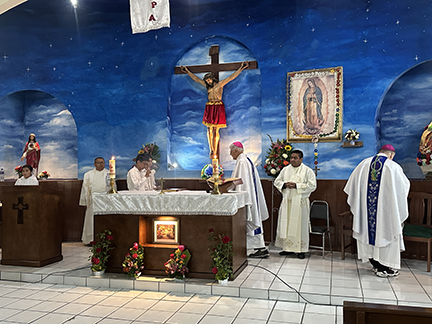
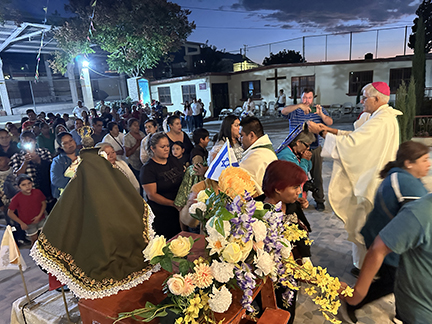


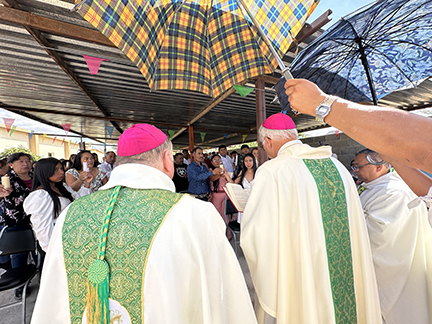
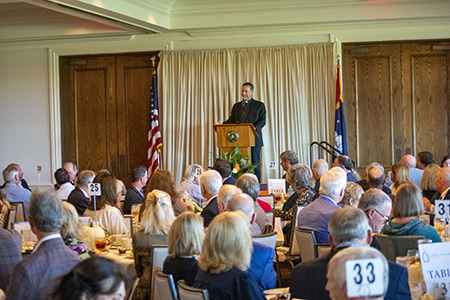
Por Joanna Puddister King
JACKSON – El evento anual Journey of Hope (Viaje de esperanza) de Catholic Charities adoptó un nuevo formato este año, llegando a toda la diócesis con dos reuniones que atrajeron a casi 800 personas para celebrar la fe, el servicio y la esperanza.
Más de 550 invitados asistieron al almuerzo del 17 de octubre en el Country Club de Jackson, mientras que otros 250 se reunieron al día siguiente en la parroquia de St. James en Tupelo, donde la atención se centró en la labor de la oficina de Catholic Charities en Vardaman, en el noreste de Misisipi.
“Cada evento reflejó cómo Catholic Charities y nuestros programas se guían por nuestra fe”, dijo Michael Thomas, director de desarrollo de Catholic Charities de Jackson. “El objetivo es siempre que todos se vayan con una sensación positiva de lo que Catholic Charities está haciendo en todo nuestro estado para mejorar la vida de tantas personas”.
El ponente destacado, el padre Burke Masters, exjugador destacado de béisbol de la Universidad Estatal de Misisipi, capellán de los Chicago Cubs y sacerdote de la Diócesis de Joliet, dijo a los invitados que el discipulado requiere el mismo compromiso y disciplina que se le exigía a él en el campo.
Según explicó, los ojeadores solían calificar a los jugadores de béisbol en función de seis “herramientas”: bateo, potencia, carrera, defensa, lanzamiento e inteligencia en el béisbol. “Era bueno en todo, pero excelente en nada”, recordó con una sonrisa. “No todos podemos convertirnos en jugadores de las Grandes Ligas, pero todos podemos convertirnos en mejores discípulos de Jesucristo”.
Ofreció un paralelo espiritual: las seis herramientas de un discípulo: crecer, dar, servir, adorar, imitar a Jesús y construir comunidad. “Todo el mundo busca un significado y un propósito”, dijo. “Y no puedo imaginar nada más significativo o con más propósito que la vida eterna”.
El padre Masters instó a los invitados a dedicar tiempo a la formación diaria. “Practicábamos cinco horas al día para ser los mejores jugadores de béisbol que pudiéramos ser”, dijo. “¿Cuánto tiempo invertimos tú y yo en nuestra vida espiritual?”
También desafió a los oyentes a acercarse a la adoración con gratitud. “No tienes que ir a la iglesia, puedes ir”, dijo. “Puedes adorar al Dios del universo”.
Thomas dijo que los ingresos del evento de Jackson se destinarán a todos los programas de Catholic Charities, mientras que las donaciones de Tupelo permanecerán en la oficina regional de Vardaman, apoyando a los ministerios que sirven a las familias y a las personas de toda la región noreste. “Los donantes saben que tienen un interés particular en lo que se logra en sus propias comunidades”, dijo.
Los eventos de este año destacaron la misión de Catholic Charities de llevar esperanza y sanación a todo el estado a través de más de dos docenas de programas, desde adopción y asesoramiento hasta intervención en casos de violencia doméstica y ayuda a inmigrantes y refugiados.
Thomas atribuyó el éxito de los eventos de Jackson a la amplia colaboración, y destacó el liderazgo de la parroquia de St. Paul, en Flowood; St. Francis of Assisi, en Madison; y St. Richard, en Jackson, que “lideraron la participación de las parroquias este año y dieron un ejemplo que esperamos que otros sigan”.
También expresó su agradecimiento a Christina Bach, directora ejecutiva de Catholic Charities; al padre Tim Murphy y al personal de St. James en Tupelo; a Michele Harris, presidenta de la junta directiva; y a Julie Gibert, que presidió el comité de desarrollo. “Todos trabajaron muy duro para recuperar nuestro Journey of Hope y convertirlo en un éxito tanto en Jackson como en Tupelo”, dijo Thomas.
Thomas señaló que el formato de doble ubicación podría continuar en los próximos años, dependiendo del ponente, y destacó la suerte que tuvieron los organizadores de que el padre Masters pudiera intervenir en ambas reuniones.
“Están sucediendo grandes cosas con nuestros programas”, añadió. “Nuestro programa Kinship Navigator se está expandiendo a Greenwood y Jackson; y Born Free tiene un nuevo director”.
Para terminar, el padre Masters compartió una historia sobre cómo recibió una réplica del anillo de la Serie Mundial de los Chicago Cubs de manos de los seminaristas mientras era director vocacional. A menudo se lo muestra a los estudiantes, que se quedan boquiabiertos antes de que él les explique que es una imitación de 15 dólares. “Parece real, pero no lo es”, dijo, y añadió que su verdadero objetivo es un premio mayor. “La corona de la gloria eterna no acumula polvo, no se desvanece y dura para siempre. Vivamos hoy como discípulos que se preparan para ese encuentro cara a cara con Dios”.
